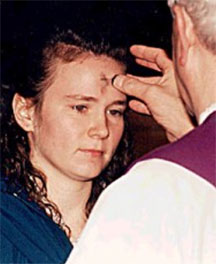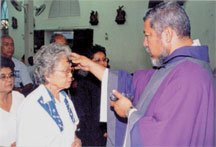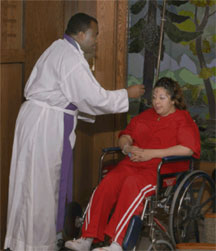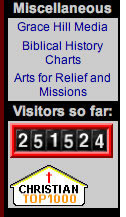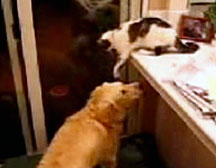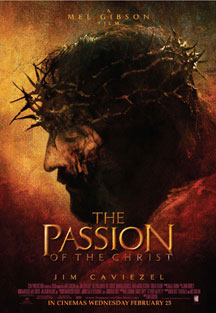| |
A Resource by Mark D. Roberts |
|
Archive for February, 2005
Note: This archive contains all of my posts for this month that are not included in some other series. I really don't have the time to save things in more than one place. If you're looking for a specific item, use the "Search" button in the upper left hand corner. Thanks. |
by Rev. Dr. Mark D. Roberts Copyright © 2005 by Mark D. Roberts
Note: You may download this resource at no cost, for personal use or for use in a Christian ministry, as long as you are not publishing it for sale. All I ask is that you give credit where credit is due. For all other uses, please contact me at mark@markdroberts.com. Thank you.
Is Bigger Better?
Posted at 9:45 p.m. on Saturday, February 5, 2005
Today I need to get something off my chest. It's one of my pet peeves. Are you ready? I get really bugged by drink size inflation. Yes, drink size inflation. Now I realize that this is a trivial thing given all that's going on in our world. But I still get bugged by drink size inflation. You know what I mean. In the good ol' days you could go to 7-Eleven and get a medium sized Coke, maybe even a twenty-ounce large if you were really thirsty. But this wasn't nearly enough sugar and caffeine for 7-Eleven's parched customers. So they invented the Big Gulp, a whole quart of tasty carbonated sugar. But when that wasn't enough, the store came out with the Super Big Gulp, which weighed in at 44 ounces, and was about the size of the average human stomach. Yet that still didn't satisfy some customers, so 7-Eleven now offers the X-treme Gulp, whose 52 ounces will quench the thirst of a whole basketball team, I figure.
But the inflation of actual drink sizes is only part of my pet peeve. There's also the inflation of drink size labels. You know what I mean. It used to be that you could go into a coffee bar and get a small coffee. But that's almost a thing of the past. Smalls are very rare today. Instead, you have to order a tall. (Although I'm not a Diedrich's regular, I have to commend the company for sticking with the old faithful small, medium, and large for their drink sizes. Hooray for a fleeting moment of honesty!
Now if you were to ask the inflating institutions why they don't serve small drinks, and why everything has to be bigger, or at least sound bigger, their answer would be simple: That's the way people want it. That's what sells. When it comes to beverages, bigger is better - bigger sizes, or at least bigger descriptions.
Churches are rather like beverages in this way. The majority of Americans, including vast numbers of Christians, think that bigger churches are better. Who wants to go to "medium sized" church when you can go to an "X-treme Gulp" church? After all, they have dazzling facilities, often with full health clubs, full-service coffee bars, twenty-piece orchestras in worship, and just about every other perk imaginable. Surely, the average person reasons, the bigger church must be better, and that's why people go there. |
|
|
|
|
But is it? Is bigger better? And if so, under what conditions? And if not, when is bigger not better? And how does this impact us? Should IPC be a bigger church? Would this be better?Or not? For the answer to these questions, continue reading by clicking here. Dust in the Wind?
Posted at 11:55 p.m. on Tuesday, February 8, 2005
I close my eyes, only for a moment, and the moment's gone
All my dreams, pass before my eyes, a curiosity
Dust in the wind, all they are is dust in the wind.
Same old song, just a drop of water in an endless sea
All we do, crumbles to the ground, though we refuse to see
Dust in the wind, all we are is dust in the wind.
Don't hang on, nothing lasts forever but the earth and sky
It slips away, and all your money won't another minute buy.
Dust in the wind, all we are is dust in the wind.
Dust in the wind, everything is dust in the wind. |
When I was in college one of my favorite songs was “Dust in the Wind” by the band Kansas (1978). Part of what attracted me to the song was the haunting music (to hear an excerpt, click here). But the lyrics were equally haunting and unsettling. “Dust in the Wind” reminds me of the Old Testament Book of Ecclesiastes, in which we read”
[H]umans have no advantage over the animals; for all is vanity. All go to one place; all are from the dust, and all turn to dust again. Who knows whether the human spirit goes upward and the spirit of animals goes downward to the earth? So I saw that there is nothing better than that all should enjoy their work, for that is their lot; who can bring them to see what will be after them? (Eccles 3:19-22)
As a Christian I don’t share the hollow despair of “Dust in the Wind,” yet I am moved by its profound statement of what life without God would be like. Like Ecclesiastes, “Dust in the Wind” doesn’t proclaim the Christian gospel. But it does encapsulate the bad news that prepares us to hear the good news of what God has done in Christ. Apart from Jesus, “all we are is dust in the wind. Everything is dust in the wind.” On Ash Wednesday we remember that we are dust. Of course we also realize that we are far more than merely dust. But Ash Wednesday gives us a chance to focus on our “dustiness,” if you will. It’s a day to remember the bad news of who we are apart from Christ so that we can begin to prepare for the great news of Good Friday and Easter. Though I grew up as an active Christian, I had very little idea of Ash Wednesday until I was well into my thirties. I always had thought of it as some arcane Catholic holiday that, thank God, we Protestants didn’t have to worry about. But in the last fifteen years I have come, not only to understand Ash Wednesday, but also to treasure its meaning.
Like Christmas, Ash Wednesday is a Christian holiday (holy day) that is not required in Scripture. So it’s nothing that all Christians must recognize. However, the day has been set apart by Christians for over a thousand years. It is the first day of Lent, a forty-day season of preparation for Holy Week and Easter. (I’ll say more about Lent in my next post.) For centuries Christians have had ashes placed on their foreheads in the shape of a cross. The ashes remind us of our mortality. As they are being “imposed” on our foreheads we hear the bad news from Ecclesiastes 3: “You’ve come from dust, and to dust you will return.” Yet, because the ashes are imposed in the shape of the cross, they also suggest the good news that is yet to come, that which will deliver us from eternal death.
Throughout my pastoral tenure at Irvine Presbyterian Church I’ve put ashes on hundreds of foreheads. It’s both a strange and a wonderful thing to do. It’s strange to tell people, in so many words, “You’re mortal and you’re going to die.” Yet it’s wonderful to remind people of why they need a Savior, and to invite them to begin getting ready for a deeper experience of God’s grace on Good Friday and Easter – even seven weeks before Holy Week begins. |
|
|
I remember distinctly times when I have put ashes on the forehead of a dear member of my church who was nearing death. And I remember occasions when I have imposed ashes on the foreheads of newborn infants. The point is that, whether old or young, we are all mortal. We are all caught in death grip of sin. And we all need a Savior.
I’ve had some church members complain about our Ash Wednesday service as “a downer.” To be sure it is not joyous in the way of most worship services. Yet we don’t simply leave ourselves to wallow in our dusty mortality. We take extra time to pray for ourselves and for each other, remembering God’s mercy. And, though we don’t yet focus on the full good news yet to come, we do sing “Great Is They Faithfulness” as we remember God’s grace. Apart from God we are indeed “dust in the wind.” Yet into our dust God has breathed, not only the breath of earthly life, but also the breath of his Spirit. Thus Ash Wednesday’s vivid reminder of our mortality leads us, not to despair, but to hope. It points not to defeat, but to the coming victory of Easter.
Staring Death in the Face
Posted at 11:15 p.m. on Ash Wednesday, February 9, 2005 The denial of death . . . it’s all around us. When people die, they are often alone, sequestered in hospitals far away from the sad eyes of friends and family. If someone happens to die at home, the corpse is quickly sent away from the grieving relatives. In polite society one doesn’t talk much about death. And when it’s necessary to say something that has to do with dying, nifty euphemisms keep us from confronting the brute facts. “Dear Fred has passed on.” “Aunt Suzy is no longer with us.”
Of course our own fears concerning our own demise fit match our cultural squeamishness about death. We don’t want to think about our own mortality, and we do many things to pretend that its not approaching. We dye our graying hair. We cover our age spots with make up. We get cosmetic surgery to preserve the image of youth. Rarely do we seriously think about our own death. As a pastor, I’m amazed at how unusual it is for someone to make plans for his or her own memorial service, or even to leave notes for the family. These are things we’d rather not have to bother with.
And then we come to Ash Wednesday, a day when we stare death in the face. Christians who observe this holiday get ashes “imposed” on their foreheads, while a minister or lay church worker says, “You have come from dust, and to dust you will return.” In other words, “You are going to die. And here are some ashes to remind you, just in case you’ve forgotten.”
In our Ash Wednesday services today I put ashes on the heads of older adults, some of whom have serious cancer and may not live much longer. I also put tiny black crosses made of ash on the foreheads of babies far too young to realize what was happening to them. I imposed ashes on teenagers and senior citizens, on men and women, on boys and girls. All of these I reminded of their mortality, and they freely received the reminder.
What gives us such freedom to think about death? Are we Christians morose? Do we have some peculiar fascination with dying? I don’t think so. Rather, what allows us to stare death in the face is the assurance of life, real life, eternal life. When we know our lives are safe in the hands of God, and that this physical life is just the beginning of eternity, then we’re free to be honest about what lies ahead for us. We can face death without fear or pretending, because we know the One who defeated death.
I’ll never forget my last visit with a dear member of my congregation named Helen. She was a tiny woman when healthy, but old age and disease had ravaged her body. I wouldn’t be surprised if she weighed 75 pounds on the day of my last visit.
There was no question that Helen was soon to die. And there was no point for me to pretend as if that weren’t true. So I asked her straightaway: “Helen, it’s obvious that you don’t have too much time left in this body. How are you feeling about dying?”
“Mark,” she said with a weak but confident voice, “I’ve lived a good, long life. I’ve been blessed far beyond what I could have hoped. You’re right, my body is giving out. I don’t have much longer to live. But I want you to know that I am ready. I’m not afraid. I’m eager to see my Lord. I hope I get to soon.”
Talk about staring death in the face! What gave Helen such unusual bluntness and boldness when it came to her own imminent death? Her faith in God. Her confidence that her life was really just beginning. Her assurance that her soul was safe in the hands of a gracious, loving God.
And so it is for Christians on Ash Wednesday. We can face death. We can admit our own mortality. We can talk openly about the limits of this life. Why? Because we know that through Christ we have entered into life eternal, the fullness of life that will not end when our bodies give out. |
|
|
|
|
|
|
| |
The emotional result of Ash Wednesday observance isn’t depression or gloom, but gratitude and new energy for living. When we realize how desperately we need God, and how God is faithful far beyond our desperation, we can’t help but offering our lives to him in fresh gratitude. And when we recognize that life doesn’t go on forever, then we find new passion to delight in the gifts of each and every day, and to take none of them for granted.
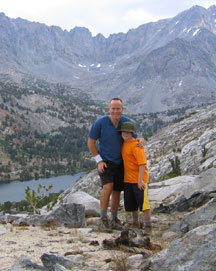 |
|
As I returned to my seat after imposing ashes upon dozens of worshipers, I sat next to my 12-year-old son. I couldn’t help but notice the prominent black cross on his forehead, placed there by another leader. All of a sudden it hit me that my dear boy will die someday. Of course I knew this in principle, but I hadn’t thought about it in years. At that moment I prayed that would give Nathan a long and blessed life. And then I hugged him for a good minute or more, treasuring the life we share together.
How grateful I am for the grace of God that allows us to stare death in the face so we can live with greater passion and delight! And how thankful I am for a day that allows me to think about death so I can cherish life even more! |
How Lent Can Make a Difference in Your Relationship with God
Posted at 10:00 p.m. on Thursday, February 10, 2005 If you’ve been reading my blog for a while, you know that I often pause during the year to comment on the meaning and practices associated with certain days and seasons of the church year. I do this, not only because these things matter to me personally, but also because I’m aware that much of this material is unfamiliar to many Christians, especially to evangelicals. I, for one, really didn’t know that there was such a thing as a church year until I was in my late 20’s. And I didn’t begin paying attention to it until I was in my mid-30’s.
I had planned to write something about the season of Lent today. I checked to see what I wrote last year and decided it was a decent enough piece. So I’ve rewritten last year’s post and put it put it up again. I say this because I believe in full disclosure, and because I don’t want any of my long-term readers to wonder why they’re having such strong feelings of déjà vu.
Growing up as an evangelical Christian, I experienced Lent as little more than a joke. "What are you giving up for Lent?" my friends would ask. "Homework," I'd say with a smirk, or "Obeying my parents." Lent was one of those peculiar practices demanded of Roman Catholics - another great reason to be Protestant, I figured.
In the last fifteen years I've discovered that Lent is in fact recognized by millions of Protestant Christians, in addition to Catholic and Orthodox believers. (The Eastern Orthodox Lent is longer than for western Christians, and it begins before Ash Wednesday.) Lent (the word comes from the Middle English word for "spring") is a six-week season in the Christian year prior to Easter. |
|
The Colors of the Liturgical Year
One of the wonderful aspects of the Christian year is the use of special liturgical colors. Even as seeing red and green decorations tells us that it’s time for secular Christmas, or seeing red, white, and blue streamers communicates “Independence Day,” so the colors of the church year help to orient and inspire our prayer and worship.
Last December I wrote two extensive blog posts on the meaning and colors of the Christian year. If you’re new to my website, you may want to check these out. The main color of Lent is purple, which signifies penitence and solemnity. (Since I don’t usually wear a robe and stole when I lead worship, I have a couple of purple ties that I wear for Lent. |
|
In the ancient church it was a time for new converts to be instructed for baptism and for believers caught in sin to focus on repentance. In time, all Christians came to see Lent as a season to be reminded of their need for penitence and to prepare spiritually for the celebration of Easter. Part of this preparation involved the Lenten "fast," giving up something special during the six weeks of Lent (but not on Sundays, in some traditions. Lent lasts for forty days, but the Sundays in Lent are not counted in the forty.).
Many Protestants rejected the practice of Lent, pointing out, truly, that it was nowhere required in Scripture. Some of these Protestants were also the ones who refused to celebrate Christmas, by the way. They wanted to avoid some of the excessive aspects of Catholic penitence that tended to obscure the gospel of grace. In time, Protestants saw Lent, at best, as something completely optional for believers, and, at worst, as a superfluous Catholic practice that true believers should avoid altogether.
Some segments of Protestantism did continue to recognize a season of preparation for Easter, however. Their emphasis was not so much on penitence and fasting as on intentional devotion to God. Protestant churches sometimes added special Lenten Bible studies or prayer meetings so that their members would be primed for a deeper experience of Good Friday and Easter. Lent was a season to do something extra for God, not to give something up. |
|
| |
A Lenten stole from a designer who has lots of creative liturgical materials for sale. |
After ignoring Lent for the majority of my life, I've paid more attention to it during the last decade. Sometimes I've given up something (like watching television or eating sweets) in order to devote more time to Bible study and prayer. Sometimes I've added extra devotional reading to my regular spiritual disciplines. I can't claim to have had any mystical experiences during Lent, but I have found that fasting from something has helped me to appreciate more deeply the meaning of the cross and the victory of the resurrection. Before I began honoring Lent, Good Friday and Easter always seemed to rush by before I could give them the attention they deserved. Now I find myself much readier to meditate upon the depth of Christ's sacrifice and to celebrate his victory over sin and death on Easter. Lent is not a requirement for Christians. But millions of us - Catholic, Orthodox, Protestant, and Independent - have found that recognizing the season of Lent enriches our worship and deepens our faith.
A Simple Lenten Discipline
Read one chapter of a gospel each day during Lent. Before you begin, ask the Lord to speak to you through his Word. Read slowly and prayerfully. Let the text sink into your mind and heart. When you've finished reading, pray about whatever has touched you. If you begin with the Gospel of Mark, you'll have enough time to read it and one other gospel during Lent. |
|
No matter how it happens, I pray that the next six weeks will be for you a time of preparation, so that you might be ready for a truer, deeper, and richer experience of God's love on Good Friday and Easter.
Sharing a Blogger’s Joy
Posted at 11:30 p.m. on Friday, February 11, 2005
| |
A Note to My New Readers
For the sake of those who are new to my blog, let me explain that I tend to do heavy blogging during the week, with lighter fare on the weekend. By Friday evening it’s time for a smile, or even a chuckle. At least that’s what I usually need! Tonight I'm a little less funny and a little more personal than normal. |
| Please pardon me if the next few sentences sound like boasting, but I want to share some of my joy and gratitude with you. This past week had blogging rewards I never imagined when I started my blog just over a year ago. For one thing, my number of visitors passed the quarter million mark. This rather amazes me, I must confess. When I began blogging, I was thrilled to get a few dozen visitors in a day. Never in my wildest dreams did I imagine that I’d be averaging well over 1,000 visitors daily in early 2005, surpassing the 250,000 mark on February 10th. Now I’m well aware that 250,000 is a low week for some of the major bloggers. But I’m blown away by the thought that so many people have thought it worthwhile to visit my site. (The 250,000 number, by the way, is real visitors, not hits, but not unique visitors. Returning visitors count each time they come back.) |
|
| |
Pic from my site today. |
 |
The other bit of happy blogging news came in the form of an e-mail from Eric Ragle of Evangelical Underground. He notified me that I had won the “2005 Best Evangelical Blog – Pastor” award. He even sent a nifty graphic. Wow! I felt very happy, honored, and encouraged.
I want to thank Eric for organizing the Evangelical Blog awards. And I also want to thank those who voted for my site. I especially want to thank my mother for voting for me 100 times! (Just kidding . . . well, who knows?) Eric’s effort has encouraged lots of Christian bloggers, and it has helped many of us learn about new sites we hadn’t known about earlier. |
Nice graphic, Eric! |
|
| So what am I supposed to do with the good news I received this week? Well, I can’t exactly take it to the bank, that’s for sure, since everything on my website is free (except my books, for which Amazon prefers to be paid). I suppose I could feel good about myself for a while. I could even imitate dear Sally Field when she won the Best Actress Oscar for Places in the Heart in 1985. You’ll remember the classic moment, when an overacting Ms. Field said, "I haven't had an orthodox career, and I've wanted more than anything to have your respect. The first time [when I won Best Actress for Norma Rae in 1980] I didn't feel it, but this time I feel it, and I can't deny the fact that you like me, right now, you like me!" I still cringe when I think of that moment. So I don’t think I’ll go down that road, thank you very much. |
|
| |
Sally Field, enjoying the fact that the Academy finally likes her.
|
But I will offer public thanks to God for the privilege of making a small difference through my blog. When I began, I hoped that somehow my blogged thoughts might help people, or churches, or even the larger society in some tiny way. In the last year I’ve been delighted to hear from many who have found some benefit from my writing. It’s a true joy to know that my blog series have been used as curriculum in church adult ed classes, or that my musings on Lent have touched people’s hearts, or that my silly pictures have added a moment of laughter in someone’s otherwise somber day. Perhaps my deepest joys in the past year of blogging came when I received e-mails from two men who, though they live on opposite sides of the globe, had similar responses to my writing. Both men were Christians who were on the verge of jettisoning their faith because of intellectual doubt. Both men found my writings on Jesus through Google, and ended up renewing their faith in Christ because of what I had written. After receiving these notes I literally wept for joy with thanks to God for the ability to make such a difference in people’s lives. I take very seriously the responsibility that comes with blogging. In fact, the more readers I have, the more I feel the weight of that burden upon my shoulders. When I write, I try as hard as I can to be truthful and helpful. I try to be kind to those with whom I disagree, and to encourage those whose thinking I appreciate. I also endeavor to address issues that will help people, both Christians and others. I’m keenly aware that because I often blog outside of my area of primary expertise (my Ph.D. is in New Testament), I often make mistakes. But I try to admit these mistakes as I make them, and to learn from them as well. I do appreciate the patience of my readers and the kindness of many who have corrected me throughout the past year. I’m finding that more and more people are writing me to ask me to address issues that burn within their hearts or that are controversial in their communities. I am honored by these requests, and will do my best to respond to them (or to point folks to other resources). Yet, once again, I ask your understanding when I can’t get to some pressing issues on a timely basis. As you may know, I do my blogging in my spare time. It’s not a part of my official duties as Senior Pastor of Irvine Presbyterian Church. In fact, I sometimes tell people that blogging is my form of lay ministry, since I get paid to be a pastor, but earn nothing from blogging. My blog is what I give away in service to God and people with no expectation of reward, other than the joys that come from serving. So, to you who have helped my visitor number break the quarter million mark, I offer sincere thanks. And to those who voted my blog as the Best Evangelical Pastor Blog in 2005, double thanks. But, most of all, I thank God for the resources that make this blog possible (my education, my laptop, Dreamweaver software, broadband Internet access, a supportive church and family, friends who have chipped in a few bucks to cover my costs, etc.). I hope and pray that I will continue to use these resources well. To God be the glory! Family Update
Posted at 9:45 p.m. on Saturday, February 12, 2005
 |
If you’ve been reading my blog for a while, you may remember that we got a new puppy last August. Sandy is a Golden Retriever, who is now seven months old. All in all she’s a great dog, though she still likes to chew things she shouldn’t, like my kids’ homework (really, twice!). |
|
Sandy on the day we brought her home |
|
|
Sandy at seven months |
 |
When Sandy joined our family, we had a sixteen-year-old cat named Caeli. Though Sandy wanted to have a personal relationship with Caeli, the cat kept the dog away with her snarls and claws. But in January Caeli died. A couple of days later we got a new cat, Lily. Sandy, of course, wanted to welcome Lily into our home. But Lily, like her predecessor, would have nothing to do with Sandy. If ever dog and cat were in the same space, Sandy would run over to say “Hi,” while Lily would scamper off to safety. |
|
| Caeli (to the left of Joseph) liked to join the characters of our nativity scene on the roof at Christmas time. Thus she disproved the rumor that cats cannot be Christians. |
|
|
Lily, striking a regal pose when she's on the refrigerator, far away from Sandy's nose. |
| But, in time, Lily has decided that Sandy isn’t dangerous. In fact, according to Lily, Sandy is rather fun to play with by taunting, teasing, and tempting. Lily has managed to find several places is the house where she is safe from Sandy’s enthusiasm, but where she is close enough to make Sandy’s life miserable. If you look carefully at the picture on the right, you can see Lily’s look of calm domination and Sandy’s feeling of utter defeat, mixed with patient longing. Poor Sandy, so close, but yet so far! |
|
| |
No luck this time, Sandy! |
 |
One last bit of family news. Yesterday my children had their mid-year orchestra concerts at school. Nathan plays the clarinette, Kara the violin. These are the sort of thing that parents and grandparents love. Music critics should probably keep away. I've included a picture of my daughter and her friends playing a bit of Beethoven's "Ode to Joy." (Those who think of Irvine, California as some lily-white suburb should look carefully at the students in the picture. My daughter is the Anglo girl, front and center.) I've heard better music in my life, but I've never felt quite as much parental pride listening to Beethoven as I did yesterday. |
|
|
Nothing too heavy today. I just thought you’d enjoy some family updates. Tomorrow I plan on starting a major series on a fairly controversial and important issue facing Christians today. Women's Retreats, Chicken Nuggets, and Biblical Truth
Posted at 11:20 p.m. on Friday, February 18, 2005
| If you’re a new reader of my blog, I should explain that I generally take on serious subjects during the week and lighter topics on the weekend. So, I’ll get back to my series on the TNIV in a couple of days. |
Well, my wife is away this weekend on a women’s retreat with women from our church. Actually, she’s speaking at this retreat, so it’s less of a retreat for her and more of a heavy work weekend. The retreat is meeting at the Murrieta Springs Conference Center, a resort now owned and operated by Calvary Chapel.
| Every time the women of our church go on retreat, and especially when my wife joins them, I think of Genesis 2:18: “The LORD God said, ‘It is not good for the man to be alone. I will make a helper suitable for him’” (ESV). There’s no better way for men to learn the truth of this verse than when their wives go away for a weekend. I’ll see proof of this on Sunday morning when harried fathers arrive at church late with their half-dressed children straggling behind crying for “Mommy.” And, no doubt I’ll discover once again why I need a helper in this life. My paraphrase of Genesis 2:18 runs like this: “The LORD God said, “That man won’t make it all by himself. He needs some serious help, now!” |
|
| |
One of the buildings at the Murrieta Hot Springs Conference Center, about two hours south of Los Angeles. |
Let me share a couple of illustrations to prove my point. A few years ago when my wife was on retreat I had the responsibility of getting my children ready for church. I did okay with my son because I’ve been dealing with male clothing and hair my whole life. But things with my six-year-old daughter were more complicated. After fiddling with her hair for ten minutes, I finally invented a simple hairstyle so we wouldn’t be late for church. As we hurried to the Sunday School building, one of the moms who didn’t go on the retreat called me aside and quietly said, “I see Kara doesn’t have her dress tied correctly. Do you want me to help?” “Yes, please,” I answered with a pleading tone in my voice. I took my son to class while this generous mom fixed Kara’s dress. By the time I returned, only a couple of minutes later, not only was her dress tied just right, but her hair had been completely redone, and it was perfect. I still don’t know how that mom did all of this in so little time, but that’s a mystery I’m happy to leave unsolved.
| Second illustration: My wife is a fine cook. Not only does she make delicious food, but she can do it while tending to all the other tasks associated with being a mom. I, on the contrary, am neither a good cook nor a particularly talented multi-tasker. So I tend to think of women’s retreat weekend as “the rest of us eat out a lot weekend.” About three years ago my children and I actually went out to eat for six consecutive meals. When my wife returned, we happily shared with her our new record for eating out. She, always the nurturing mom, asked my kids what they ate when we went out. My daughter immediately blurted out: “Chicken nuggets!” Linda followed up, “When did you have chicken nuggets, Kara?” “All the time,” she answered gleefully. “At every meal?” Linda responded uncertainly. “Well, not |
|
| |
For those who think that all chicken nuggets are alike, this picture proves beyond a shadow of a doubt that there is some variation of shape, at least. |
| breakfast,” Kara explained, “but the other meals.” Turning to me with a questioning gaze, Linda asked, “So how many times did she have chicken nuggets?” Of course I didn’t know. But we soon determined that Kara had eaten these paragons of nutrition for Friday dinner, Saturday lunch, Saturday dinner, and Sunday lunch. I’m afraid my “good dad” score plummeted at that moment as Linda wondered whether we should check Kara’s cholesterol and rush her to the emergency hospital. But I saw this event more positively than Linda did. It proved that God was right all along: it’s not good for a man to be alone, especially when he has to clothe and feed children. |
It’s great that the women of my church are on retreat. They’ll get a badly needed and well deserved break, and some valuable input from a fantastic speaker, I might add. And when they get back, the dads and children who have survived the weekend will demonstrate the truth of yet another passage of Scripture, in addition to Genesis 2:
A wife of noble character who can find?
She is worth far more than rubies . . . .
She watches over the affairs of her household
and does not eat the bread of idleness [Indeed!].
Her children arise and call her blessed;
her husband also, and he praises her (Prov 31:10, 27-28, ESV)
In the words of the Cowardly Lion from The Wizard of Oz, “Ain’t it the truth? Ain’t it the truth?”
Family Update, Part 2
Posted at 11:30 p.m. on Saturday, February 19, 2005
 |
A week ago I put up some pictures of the newest members of our family, a dog named Sandy and a cat named Lily. You may recall that I described how Lily, at one-seventh of Sandy’s size, has found lots of ways to taunt Sandy, mostly by placing herself safely out of reach, yet close enough to Sandy’s nose to rub it in. One example is in the picture to the right, which I had put up a week ago. You can see the look of sad resignation on Sandy's face, while Lily's exalts in her intellectual superiority. |
Well, Lily’s newest discovery is that she can sit on the kitchen counter and use Sandy’s nose as a punching bag. This isn’t a real fight, because Lily never uses her claws. And neither animal gets upset enough to try to hurt the other or to run away. Instead, Sandy plays the “straight man,” patiently trying to get a good sniff of Lily, while Lily keeps whacking Sandy on the nose. If you’re curious, you may want to check out the short clip of tonight’s main event. Just click on the image to the right. (Just to clarify: No animal was harmed during the making of this film. All noises were added later by our effects department.) |
|
I hope I've lightened your load a bit today, thanks to the antics of Lily and Sandy. Tomorrow I’ll return to more serious matters, as I get back to the TNIV translation controversy.
The Passion of the Christ: One Year Later
Posted at 9:35 p.m. on Friday, February 25, 2005
A Note to New Blog Readers
On the weekend I usually take a break from whatever series I’ve been doing during the week. Often my weekend posts are humorous or inspirational. Sometimes, as will be the case today and tomorrow, I simply reflect on issues that I think you'll find interesting. At any rate, this gives my brain a break from the hard work of the week – something my readers seem to appreciate as much as I do. |
Today The Passion of the Christ is one year old. I thought I'd reflect a bit on the film and its impact, as well as on the forthcoming "recut" version (tomorrow). Last February was a busy time for me because of the pending February 25th release of Mel Gibson's controversial film. I had written a review for Worship Leader magazine’s January-February issue, which ended up being distributed by the hundreds of thousands. On my website I posted a long, detailed review of the movie which brought more than 18,000 visitors in February, a record for my two-month old site. Since then another 18,000 people have visited the webpage that contains my Passion review. A year ago I also found myself in e-mail dialogue with persons from across the religious spectrum: Catholics, evangelical Christians, atheists, Jews, and others. I also did a series of radio interviews in advance of the movie’s release. (If a radio show wasn’t big enough to get the heavy hitters, like Mel Gibson, Jim Caviezel, or Abraham Foxman, they were willing to let me pinch hit.)
As you may recall, many Jewish leaders had condemned The Passion of the Christ as anti-Semitic, claiming that it was dangerous to Jews. Some even predicted mass violence against Jews from moviegoers. I had gone on record as saying that the vast, vast majority of people who saw The Passion of the Christ would not even think to blame Jews today for the death of Jesus. In fact, I had argued that this film had the potential to improve Jewish-Christian relations if Jews and Christians grasped the opportunity presented to them.
Many Christians were ecstatic about the evangelistic potential of the movie. One popular PR slogan touted the film as “The greatest evangelistic opportunity in 2000 years.” Many churches rented out whole theatres so that church members might bring unsaved friends to the film. I felt less enthusiastic than many Christians about the evangelistic possibilities afforded by The Passion of the Christ. After all, the movie did not even try to tell the full story of the good news of Jesus, and I feared its extreme violence might actually put off some people who weren’t already familiar with the story of Christ’s death. I did think the film could serve as pre-evangelism, a great conversation starter. |
|
As February 25th, 2005 rolled around, many questions swirled in my mind and in the media: Would The Passion of the Christ lead to violence against Jews? Would the film lead instead (or also) to thousands of Christian conversions? What would be the real impact of the film’s release? Would people see the film in large numbers? Or would it be a box office bomb? Exactly one year ago today my wife and I saw The Passion of the Christ. It was early in the day on Ash Wednesday and we wanted to avoid the crowds. The theatre in which we saw the movie was about half full. The audience was mixed in many ways, though I didn’t see any children under 12 present as the movie began. Seeing this movie was one of the oddest movie-going experiences of my life for a number of reasons. For one thing, there were no previews before the movie started, no trailers full of bathroom humor and earsplitting car chases; just a silent dark screen and then the movie. Even though I had seen an advance screening of the film, I found myself utterly entranced, utterly on-edge for the entire two hours and seven minutes of the movie. When the movie ended, my wife and I sat in silence for a long time, joined by most others in the theatre. Finally the silence was interrupted by the voice of a three-year-old child several rows behind me proclaiming, “No more movie! No more movie!” Had I not been dumbstruck by the awesomeness of God’s grace at that moment, I would have shot the parents of that little girl the world’s meanest look. I still can’t imagine what they were thinking. Nevertheless, for me personally, seeing The Passion of the Christ was a profound experience of worship, worship directed not at Mel Gibson or Jim Caviezel by the way, but at the One who had suffered to terribly in dying for my sin. In the days following the film’s release I watched the news stories closely to see whether the predictors of gloom or the predictors of glory would be right. The popularity of The Passion of the Christ exceeded almost everybody’s expectations. It turned out to be a behemoth at the box office, grossing $370 million in the U.S.A. and $611 million overall in 2004. If the ticket price averaged $8.00 in the U.S., this means that 46 million people saw the film. And I don’t think you can chalk that up to junior high boys going to the film again and again. Later in the year the sales and rentals of the video or DVD amounted to $245 million more. All of this certainly amounted to a kind of vindication for Mel Gibson, at least on the popularity and financial success front. The dreaded anti-Jewish response to The Passion of the Christ didn’t materialize. I remember reading a couple of reports of anti-Jewish slurs being hurled at Jews in a couple of places. This was inexcusable, of course. But all of the dire warnings proved to be unwarranted. In fact, in many cases The Passion of the Christ advanced the cause of Jewish-Christian relations. I, for one, learned more than I had ever known before about anti-Semitism, and wrote a couple blog posts on the subject (1, 2). Furthermore, the Jewish and Community Research found that people who saw The Passion of the Christ were actually less likely to blame Jews in general for killing Christ. Tomorrow I’ll continue this discussion of The Passion of the Christ, reflecting on its evangelistic impact and on the new version of the film that is soon to hit theatres. I’ll put up what may be the world’s only transcript of Mel Gibson’s own description of the new version of the film that he’s about to release. Stay tuned . . . . The Passion of the Christ: One Year and One Day Later
Posted at 10:35 p.m. on Saturday, February 26, 2005
A Note to New Blog Readers
On the weekend I usually take a break from whatever series I’ve been doing during the week. Often my weekend posts are humorous or inspirational. Sometimes, as will be the case today and tomorrow, I simply reflect on issues that I think you'll find interesting. At any rate, this gives my brain a break from the hard work of the week – something my readers seem to appreciate as much as I do. |
Yesterday was the one-year anniversary of the release of The Passion of the Christ. In yesterday’s post I wrote about some of my personal experiences related to the film’s release and also about it’s popularity and apparent positive impact on Jews, many of whom feared the worse before the movie was actually released. But what about the film’s evangelistic impact? Many churches throughout the country used The Passion of the Christ as a way of exposing non-Christian people to Jesus. They rented out theatres and had members invite their friends to see the film. As I mentioned in my last post, some folks actually touted The Passion of the Christ as “the greatest evangelistic opportunity in 2005 years.” Well, how did things turn out on the evangelistic front? Saddleback Community Church, where Rick Warren is Senior Pastor, apparently added 2,500 members in the days after the film’s release. (I added “apparently,” not because I don’t trust whatever Saddleback would officially report, but because I have only secondhand testimony to these numbers.) But I did not hear of any mass conversions as a result of The Passion of the Christ. What I did hear was that many who already believed in Jesus had a profound experience of his love and grace, an experience that might well lead them to share this with non-believers. Last summer the Barna Group did a survey in which they tried to gauge the national response to The Passion of the Christ. Barna found that the number of conversions among those who saw the film was less than one-tenth of one-percent. This doesn’t sound like much, but if you run the numbers the result is surprising. Barna found that 31% of adult Americans saw The Passion of the Christ, or 64,000,000 people (31% of the 208,000,000 adults in the U.S.). The actual box office numbers suggest a slightly smaller total, but let’s stick with Barna’s findings. If less than one-tenth of 1% converted – let’s assume, conservatively, that it was actually one-twentieth of 1% -- this means that 32,000 adults converted to Christianity as a result of the movie. If this is true, it doesn’t match the early hype by some Christian leaders, but it isn’t something to sneeze at either. I still believe that the major evangelistic impact of The Passion of the Christ has yet to be felt. As the DVD is played for years to come, millions of Christians will grow in their love for and commitment to Christ. This will inflame their desire to share the good news of Jesus with others. The result will be more extensive and, pardon me, passionate personal evangelism.
| As it turns out, we will have a chance to see The Passion of the Christ in the theatres once again. But the film that comes out on March 11, 2005 won’t be exactly the same as the one we saw last year. In fact the movie soon to be released is called, officially, The Passion Recut. Mel Gibson has personally cut five or six minutes out of the original film. |
|
At The Passion Recut website there is a short video clip in which Gibson explains his rationale. Just click on the link called “Mel Gibson’s Introduction.” If you want the words without the download time, here’s my transcript of Gibson’s explanation:
 |
Hi. The Passion Recut. I suppose you want the scoop. Thank you, by the way, for all the support you gave me out there, and many of you who really loved the film wrote in and told me. But there was some of you who said that you wished you could have taken your Aunt Martha, Uncle Harry, or your grandmother, or some of your older kids, and you thought that perhaps the intensity of the film was prohibitive to those people. So I listened to that and it inspired me to recut the film to cater to those people who perhaps might not have seen it because if its intensity or brutality. It’s about five minutes, six minutes less. And indeed I have softened it somewhat. It’s still a hard film. I maintain the integrity of the film I wanted to make, yet alleviated some of the more horrific aspects of it. So I’m hoping that it will attract wider audiences and I hope you like it. I like it. Bye. |
Mel waves goodbye at the end of the video clip.
|
|
Ironically, just a couple of days before I learned about The Passion Recut, I was talking with my wife about seeing the original movie again. “I want to watch it,” I said, “but I’m halfway tempted to fast forward through the flogging scene. That was so hard to watch I don’t know if I want to watch it again.” I’ll bet that’s most of what Gibson cut out of the movie. Doubly ironically, a few days after I saw the film last year, I wrote a blog post called “Misplaced Passion.” In this post I suggested that the extreme physical violence of the movie, especially the flogging, might detract from the spiritual sacrifice of Christ. In fact I wrote,
Though I continue to marvel at Mel Gibson's faithful skill and to be extremely grateful for his contribution to my own faith, if I were his theological advisor, I'd tell him to back off somewhat in the beatings and flogging so as not to overshadow the ultimate horror of the crucifixion.
Well, just for the record, Mel didn’t call to ask for my opinion on The Passion Recut. If he had, I would have given him the thumbs up on the revised version.
Speaking of revised versions, tomorrow I’ll get back to my series on the TNIV translation controversy. Maybe things would have gone better for this translation if they had called it The TNIV Recut. |
|
|
Home |










